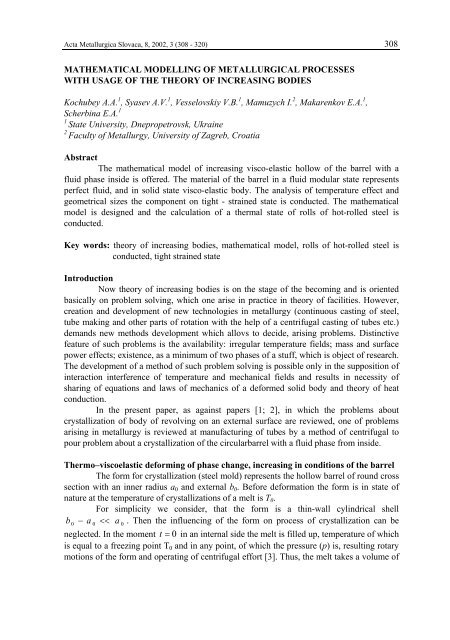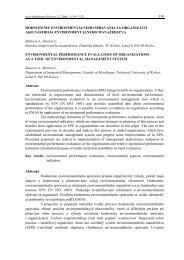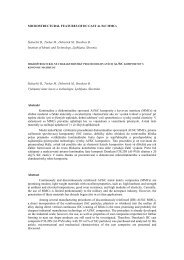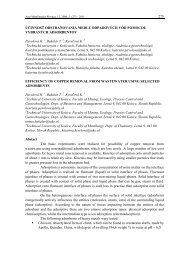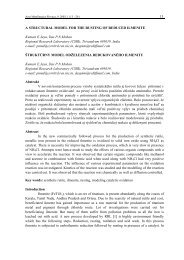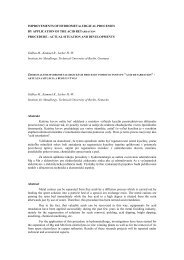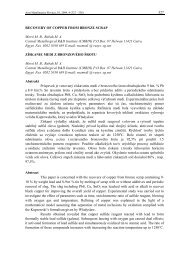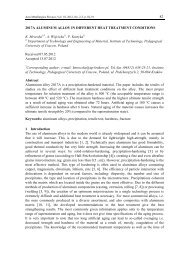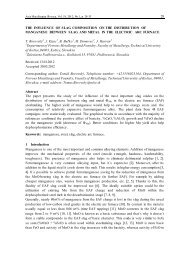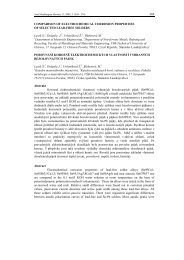mathematical modelling of metallurgical processes with usage - Acta ...
mathematical modelling of metallurgical processes with usage - Acta ...
mathematical modelling of metallurgical processes with usage - Acta ...
You also want an ePaper? Increase the reach of your titles
YUMPU automatically turns print PDFs into web optimized ePapers that Google loves.
<strong>Acta</strong> Metallurgica Slovaca, 8, 2002, 3 (308 - 320) 308<br />
MATHEMATICAL MODELLING OF METALLURGICAL PROCESSES<br />
WITH USAGE OF THE THEORY OF INCREASING BODIES<br />
Kochubey A.A. 1 , Syasev A.V. 1 , Vesselovskiy V.B. 1 , Mamuzych I. 2 , Makarenkov E.A. 1 ,<br />
Scherbina E.A. 1<br />
1<br />
State University, Dnepropetrovsk, Ukraine<br />
2<br />
Faculty <strong>of</strong> Metallurgy, University <strong>of</strong> Zagreb, Croatia<br />
Abstract<br />
The <strong>mathematical</strong> model <strong>of</strong> increasing visco-elastic hollow <strong>of</strong> the barrel <strong>with</strong> a<br />
fluid phase inside is <strong>of</strong>fered. The material <strong>of</strong> the barrel in a fluid modular state represents<br />
perfect fluid, and in solid state visco-elastic body. The analysis <strong>of</strong> temperature effect and<br />
geometrical sizes the component on tight - strained state is conducted. The <strong>mathematical</strong><br />
model is designed and the calculation <strong>of</strong> a thermal state <strong>of</strong> rolls <strong>of</strong> hot-rolled steel is<br />
conducted.<br />
Key words: theory <strong>of</strong> increasing bodies, <strong>mathematical</strong> model, rolls <strong>of</strong> hot-rolled steel is<br />
conducted, tight strained state<br />
Introduction<br />
Now theory <strong>of</strong> increasing bodies is on the stage <strong>of</strong> the becoming and is oriented<br />
basically on problem solving, which one arise in practice in theory <strong>of</strong> facilities. However,<br />
creation and development <strong>of</strong> new technologies in metallurgy (continuous casting <strong>of</strong> steel,<br />
tube making and other parts <strong>of</strong> rotation <strong>with</strong> the help <strong>of</strong> a centrifugal casting <strong>of</strong> tubes etc.)<br />
demands new methods development which allovs to decide, arising problems. Distinctive<br />
feature <strong>of</strong> such problems is the availability: irregular temperature fields; mass and surface<br />
power effects; existence, as a minimum <strong>of</strong> two phases <strong>of</strong> a stuff, which is object <strong>of</strong> research.<br />
The development <strong>of</strong> a method <strong>of</strong> such problem solving is possible only in the supposition <strong>of</strong><br />
interaction interference <strong>of</strong> temperature and mechanical fields and results in necessity <strong>of</strong><br />
sharing <strong>of</strong> equations and laws <strong>of</strong> mechanics <strong>of</strong> a deformed solid body and theory <strong>of</strong> heat<br />
conduction.<br />
In the present paper, as against papers [1; 2], in which the problems about<br />
crystallization <strong>of</strong> body <strong>of</strong> revolving on an external surface are reviewed, one <strong>of</strong> problems<br />
arising in metallurgy is reviewed at manufacturing <strong>of</strong> tubes by a method <strong>of</strong> centrifugal to<br />
pour problem about a crystallization <strong>of</strong> the circularbarrel <strong>with</strong> a fluid phase from inside.<br />
Thermo–viscoelastic deforming <strong>of</strong> phase change, increasing in conditions <strong>of</strong> the barrel<br />
The form for crystallization (steel mold) represents the hollow barrel <strong>of</strong> round cross<br />
section <strong>with</strong> an inner radius a 0 and external b 0 . Before deformation the form is in state <strong>of</strong><br />
nature at the temperature <strong>of</strong> crystallizations <strong>of</strong> a melt is T 0 .<br />
For simplicity we consider, that the form is a thin-wall cylindrical shell<br />
b<br />
0<br />
− a<br />
0<br />
<strong>Acta</strong> Metallurgica Slovaca, 8, 2002, 3 (308 - 320) 309<br />
an internal side <strong>with</strong> radius a 1 . At the same time temperature <strong>of</strong> an external part is<br />
instantaneously T < lowered up to value and the part <strong>of</strong> a stuff located in liquid<br />
1<br />
T 0<br />
(a melt) passes in a firm modular state (solid phase). Thus, there is an escalating <strong>of</strong> stuff<br />
owing to phase change, instead <strong>of</strong> owing to attachment <strong>of</strong> stuff from the outside, as it was<br />
supposed in papers [4 - 6].<br />
We shall introduce in the undeformed configuration the cylindrical coordinate<br />
system <strong>of</strong> the axis (r, ϑ, z), which z coincides <strong>with</strong> an axis <strong>of</strong> the form, and unit vectors<br />
designated by е r , е ϑ, е z . It is required to define temperature T castings, the law <strong>of</strong> motion <strong>of</strong> a<br />
demarcation <strong>of</strong> phases a(t) and is tight - strained state <strong>of</strong> casting.<br />
The temperature variation T − T<br />
0 is considered small enough, so that heat expansion <strong>of</strong><br />
stuff can be neglected. We shall consider, that the behavior <strong>of</strong> a stuff <strong>of</strong> casting in liquid is<br />
described by equations <strong>of</strong> state <strong>of</strong> ideal incompressible fluid [7], and in solid - equations <strong>of</strong><br />
state <strong>of</strong> an incompressible visco-elastic body in case <strong>of</strong> the linear law <strong>of</strong> a creep.<br />
The <strong>mathematical</strong> formulation is reduced to a following set <strong>of</strong> equations<br />
σ<br />
1<br />
−<br />
1<br />
ij<br />
= p δ ij<br />
∂ σ<br />
∂ r<br />
σ<br />
= −<br />
−σ<br />
r , i r,<br />
i ϑ,<br />
i<br />
r<br />
( i = 1,2 )<br />
σ<br />
t,<br />
r)<br />
− σ ( t,<br />
r)<br />
= 2G<br />
( t −τ*) ( ε ( t,<br />
r)<br />
− ε ( t,<br />
)) −<br />
r, 2( ϑ,2<br />
2<br />
r,2<br />
ϑ,<br />
2<br />
r<br />
−<br />
t<br />
∫<br />
τ *<br />
R(<br />
t −τ<br />
*, τ −τ<br />
*) ( ε<br />
r , 2<br />
( τ , r)<br />
− εϑ<br />
,2<br />
( τ , r))<br />
dτ<br />
∂ u&<br />
u<br />
ε r<br />
+ ε ϑ<br />
= 0 ,<br />
r<br />
&<br />
& ε<br />
r<br />
= , & εϑ<br />
= , T ′ + T ′ / r = 0<br />
(1)<br />
∂ r<br />
r<br />
<strong>with</strong> initial and boundary conditions<br />
u r<br />
( *( r)<br />
, r) = ε ( τ *( r)<br />
, r) = 0<br />
τ<br />
ϑ<br />
, σ = 0,<br />
σ = − p<br />
T ( ) = , ( a()<br />
t )<br />
a 0<br />
T 1<br />
r r =a0<br />
r r= a(<br />
t )<br />
T = T 0<br />
, λ T ′ = ρ µ a(t & )<br />
(2)<br />
In the formulas (1), (2) and hereinafter index "1" corresponds to a stuff in liquid; an<br />
index "2" - solid phase; p 1 - pressure arising in a melt; δ ij - components <strong>of</strong> a metric tensor in<br />
an initial configuration; G ( t − *) – elastic-moment module <strong>of</strong> deformation;<br />
2<br />
τ<br />
R ( t −τ *, τ −τ<br />
*) – core <strong>of</strong> a relaxation <strong>of</strong> a visco-elastic stuff; τ * – time <strong>of</strong> a germing <strong>of</strong> a<br />
stuff <strong>of</strong> a solid phase; λ – thermal conductivity; ρ – density <strong>of</strong> a melt; µ – latent heat <strong>of</strong> a<br />
melting.<br />
The problem (1), (2) was decided, using the approach which has been set up in<br />
paper [2; 8]. In outcome the following determining ratio were obtained:
<strong>Acta</strong> Metallurgica Slovaca, 8, 2002, 3 (308 - 320) 310<br />
Law <strong>of</strong> motion <strong>of</strong> a demarcation <strong>of</strong> phases –<br />
where<br />
t<br />
2<br />
2<br />
⎛ T ⎞<br />
1<br />
1 a*<br />
( t)<br />
a*<br />
( )<br />
⎜1<br />
− − = lna*<br />
( t)<br />
−<br />
T<br />
⎟<br />
⎝ 0 ⎠ 4 2<br />
4<br />
1 t<br />
Λ<br />
−<br />
2<br />
a0<br />
ρ µ a(<br />
t)<br />
Λ = , a<br />
*(<br />
t)<br />
=<br />
λ T<br />
a<br />
0<br />
0<br />
(3)<br />
temperature field –<br />
T0<br />
−T1<br />
T = T1 +<br />
ln( r a0)<br />
(4)<br />
ln( a(<br />
t) / a )<br />
tight-strained state –<br />
u r<br />
( t,<br />
r )<br />
D ( t ) − D ( τ * ( r ))<br />
,<br />
r<br />
0<br />
D(<br />
t)<br />
− D(<br />
τ * ( r))<br />
r<br />
= − ε<br />
r<br />
( t,<br />
r)<br />
= εϑ<br />
( t,<br />
r)<br />
=<br />
2<br />
t<br />
* *<br />
*<br />
[ 2G<br />
( t − τ *)( D ( t)<br />
− D ( τ *)) − R( t − τ , τ − τ )( D( τ ) D ( τ<br />
) dτ<br />
]<br />
2<br />
σ<br />
r<br />
( t,<br />
r)<br />
− σ ϑ ( t,<br />
r ) = −<br />
2 s<br />
∫ −<br />
r<br />
a0<br />
t<br />
2dr<br />
⎡<br />
*<br />
*<br />
* *<br />
*<br />
σ<br />
r<br />
( t,<br />
r ) = ∫<br />
⎢2G<br />
S<br />
( t − τ )( D () t − D ( τ<br />
) − ( t τ τ τ )( D () τ D ( τ<br />
) dτ<br />
]<br />
r<br />
∫ − , − − . (5)<br />
3<br />
r ⎢<br />
*<br />
⎣<br />
τ<br />
The function D(t) is determined from an integral equation –<br />
τ<br />
where<br />
t<br />
H<br />
1<br />
( t)<br />
D(<br />
t)<br />
−<br />
∫<br />
H<br />
2<br />
( t,<br />
τ ) D(<br />
τ ) =<br />
0<br />
p<br />
a(<br />
t)<br />
2dr<br />
H1(<br />
t)<br />
=<br />
∫<br />
2Gs<br />
( t −τ *) ,<br />
3<br />
r<br />
a0<br />
H<br />
t<br />
2a&<br />
( τ ) ⎡<br />
⎤<br />
t,<br />
τ ) = ⎢2Gs<br />
( t −τ<br />
*) + ∫ R(<br />
t − s,<br />
τ − s)<br />
ds⎥<br />
a ( τ ) ⎢⎣<br />
τ<br />
⎥⎦<br />
2<br />
(<br />
3<br />
The numerical outcomes are submitted in a figure 1-6 at following values <strong>of</strong> main<br />
specifications:<br />
∂µ<br />
( t,<br />
τ )<br />
−<br />
R ( t,<br />
τ ) = , ( , ) 2 ( ) ( )(1<br />
γ ( t−τ )<br />
µ t τ = G τ −ϕ<br />
τ − e )<br />
∂τ<br />
( ) ( )С<br />
G = const.,<br />
− β τ<br />
τ = 2G C + A e 0 = 0.38; А 0 =0.55; β = 0.015 h -1 ; γ = 0.1 h -1<br />
ϕ<br />
0 0
<strong>Acta</strong> Metallurgica Slovaca, 8, 2002, 3 (308 - 320) 311<br />
t<br />
2,0<br />
1,5<br />
2<br />
1,0<br />
0,5<br />
1<br />
a * (t)<br />
0,0<br />
0,0 0,1 0,2 0,3 0,4 0,5 0,6 0,7 0,8 0,9 1,0<br />
τ * ( a ) *<br />
4,00<br />
3,75<br />
3,50<br />
3,25<br />
3,00<br />
2,75<br />
2,50<br />
2,25<br />
2,00<br />
1,75<br />
1,50<br />
1,25<br />
1,00<br />
0,75<br />
0,50<br />
0,25<br />
0,00<br />
l = 0.25<br />
l = 0.5<br />
l = 0.75<br />
l = 1<br />
0,0 0,1 0,2 0,3 0,4 0,5 0,6 0,7 0,8 0,9 1,0<br />
T 1 / T 0<br />
Fig.1 The law <strong>of</strong> motion <strong>of</strong> a solidified front <strong>of</strong><br />
crystallization<br />
Fig.2 Relation <strong>of</strong> time <strong>of</strong> a crystallization from<br />
temperature and geometrical sizes <strong>of</strong> casting<br />
In a figure 1 the graph<br />
a = a<br />
( * *<br />
t<br />
)<br />
– law <strong>of</strong> motion <strong>of</strong> a solidified front <strong>of</strong><br />
crystally zation submitted at Λ = 1.5. The curve 1 corresponds to value T 1 /T 0 = 0.5, and<br />
curve 2 – value T 1 /T 0 = 0.9. The outcomes <strong>of</strong> calculations demonstrate, that the temperature<br />
variation <strong>of</strong> an environment renders essential influencing on process <strong>of</strong> a crystallization <strong>of</strong><br />
casting.<br />
The schedules figured in a figure 2 illustrate relation <strong>of</strong> time <strong>of</strong> a crystallization <strong>of</strong><br />
casting to value <strong>of</strong> a temperature variation T 1 /T 0 at different fixed values <strong>of</strong> depth<br />
l =<br />
a<br />
0<br />
− a(t)<br />
a<br />
0<br />
<strong>of</strong> the done pert. The outcomes <strong>of</strong> calculations demonstrate, that the change <strong>of</strong> the<br />
geometrical sizes <strong>of</strong> casting exerts influence on duration <strong>of</strong> process <strong>of</strong> crystallization.<br />
Namely: at increase <strong>of</strong> depth l walls <strong>of</strong> casting from value 0,25 up to value 0,75 at the<br />
temperature <strong>of</strong> T 1 /T 0 = 0.5 the time <strong>of</strong> a crystallization <strong>of</strong> casting increases in 6.3 times, and<br />
at the temperature <strong>of</strong> T1/T 0 =0.9 in 7 times, that confirms also temperature effect on time <strong>of</strong><br />
a crystallization. Besides, the temperature variation T 1 /T 0 , influences on duration <strong>of</strong> process<br />
<strong>of</strong> crystallization and for separately taken wall thickness <strong>of</strong> casting. For example, at value <strong>of</strong><br />
depth l = 0. 5 the time indispensable for a crystallization <strong>of</strong> casting at the temperature <strong>of</strong><br />
T 1 = 0. 9 T 0 is in 4.5 times more, than in a case T1 = 0.5 T 0 . It speaks that, as well as in case<br />
<strong>of</strong> a crystallization on an external surface (external escalating) the temperature variation<br />
renders smaller influencing on duration <strong>of</strong> process <strong>of</strong> a crystallization, than change <strong>of</strong> the<br />
geometrical sizes.<br />
In a figure 3 the relation <strong>of</strong> time <strong>of</strong> a crystallization <strong>of</strong> casting to values <strong>of</strong><br />
temperature T 1 /T 0 for case <strong>of</strong> crystallization on an internal surface (internal escalating) –<br />
continuous line and external – dotted curve is shown. These outcomes allow to make<br />
following conclusions: the time <strong>of</strong> crystallization depends on its direction - at external<br />
escalating this time will be more; the time <strong>of</strong> crystallization depends on value <strong>of</strong> temperature<br />
T /T , and, than this relation is more, the more time <strong>of</strong> crystallization irrespective <strong>of</strong> a<br />
1 0
<strong>Acta</strong> Metallurgica Slovaca, 8, 2002, 3 (308 - 320) 312<br />
τ * ( a * )<br />
10,0<br />
9,5<br />
9,0<br />
8,5<br />
8,0<br />
l = 0.5 внутр. наращивание<br />
7,5<br />
l = 0.5 внешн. наращивание<br />
7,0<br />
6,5<br />
6,0<br />
5,5<br />
5,0<br />
4,5<br />
4,0<br />
3,5<br />
3,0<br />
2,5<br />
2,0<br />
1,5<br />
1,0<br />
0,5<br />
T 1 / T 0<br />
0,0<br />
0,0 0,1 0,2 0,3 0,4 0,5 0,6 0,7 0,8 0,9 1,0<br />
0,25 D *<br />
(t)<br />
0,20<br />
0,15<br />
2<br />
0,10<br />
0,05<br />
1<br />
r*<br />
0,00<br />
0,0 0,1 0,2 0,3 0,4 0,5 0,6 0,7 0,8 0,9 1,0<br />
Fig.3 Temperature effect <strong>of</strong> the form(shape) <strong>of</strong><br />
a on time <strong>of</strong> crystallization<br />
Fig.4 Temperature effect <strong>of</strong> the form for radial<br />
movings<br />
direction <strong>of</strong> crystallization is and at tendency T 1 /T 0 to unit <strong>of</strong> the time <strong>of</strong> crystallization aims<br />
at infinity.<br />
For research <strong>of</strong> temperature effect T 1 <strong>of</strong> an external side on formation <strong>of</strong><br />
tight-trained state during a crystallization <strong>of</strong> casting we shall put numerical results in the<br />
schedules (figure 4), illustrating relation to polar radius <strong>of</strong> a function D(t), describing radial<br />
moving <strong>of</strong> points <strong>of</strong> cylindrical casting, at different values <strong>of</strong> temperature – the curve 1<br />
corresponds to value T 1 /T 0 = 0.5, and curve 2 – value T 1 /T 0 = 0.9. From a figure 4 it is<br />
visible, that at temperature rising the values <strong>of</strong> radial movings <strong>of</strong> points <strong>of</strong> casting increase<br />
more than in 10 times.<br />
Besides, in a figure 5 the law <strong>of</strong> motion <strong>of</strong> a demarcation <strong>of</strong> phases is submitted at<br />
different directions <strong>of</strong> crystallization for miscellaneous values <strong>of</strong> temperature T 1 /T 0 . The<br />
smooth<br />
curve corresponds to value T 1 /T 0 =0.5, curve <strong>with</strong> points – value T 1 /T 0 =0.9. The<br />
continuous lines fall into to a case <strong>of</strong> internal escalating, dashed - known solution at external<br />
escalating [1].<br />
The outcomes <strong>of</strong> calculations demonstrate, that at temperature rise T 1 from value<br />
0.5T 0 up to value 0.9T 0 , the time indispensable for crystallization <strong>of</strong> all volume is from<br />
inside augmented in 5 times, and at formation <strong>of</strong> casting <strong>with</strong> wall thickness, for example<br />
l = 0.25 at the same temperature variation the time increases in 2.6 times. Such matchings<br />
can be conducted and further in more details <strong>with</strong> the help <strong>of</strong> the schedules figured in a<br />
figure 6, which enable to compare influencing depth l walls <strong>of</strong> casting on time <strong>of</strong><br />
crystallization at different directions <strong>of</strong> escalating and values <strong>of</strong> temperature T 1 /T 0 .<br />
Continuous lines, as well as earlier - crystallization from inside, dashed - out <strong>of</strong> door.<br />
From a figure 6 it is visible, that the time indispensable for manufacturing<br />
(crystallization) <strong>of</strong> a part <strong>of</strong> the definite size at external escalating is much more, than at<br />
in ternal. It speaks that the methods <strong>of</strong> internal escalating, at least, are more costeffective<br />
from the point <strong>of</strong> view <strong>of</strong> costs <strong>of</strong> time. For example, to produce a part <strong>with</strong> final wall<br />
thickness l = 0. 75 at the temperature <strong>of</strong> T 1 /T 0 = 0.45 by methods <strong>of</strong> external escalating, it is<br />
required time in 2 times more, than at internal escalating. This difference will grow <strong>with</strong><br />
increase <strong>of</strong> temperature.<br />
Thus, the time difference <strong>of</strong> crystallization will be unessential only
<strong>Acta</strong> Metallurgica Slovaca, 8, 2002, 3 (308 - 320) 313<br />
for parts, for which l ≤ 0. 25 . For remaining parts even at small temperatures, and it is not<br />
always possible on technology, the internal escalating has advantage in time.<br />
The analysis <strong>of</strong> the obtained outcomes demonstrates, that the temperature variation<br />
<strong>of</strong> an external side and geometrical sizes <strong>of</strong> casting renders essential influencing on process<br />
<strong>of</strong> crystallization <strong>of</strong> casting, and as a consequent and on tight-strained state in a part. So, for<br />
example, at temperature rising not only the time <strong>of</strong> crystallization is rising, but also<br />
essentially tight-strained state changes. Namely, at increasing <strong>of</strong> relative temperature T 1 /T 0<br />
twice – the maximum shearing stresses on an internal part <strong>of</strong> casting (at external escalating)<br />
increase in 28 times. As to movings, they also <strong>with</strong> increasing <strong>of</strong> temperature are increasing<br />
approximately in 22 times at external escalating and more than in 10 times at internal<br />
escalating.<br />
a * ( t )<br />
4<br />
3<br />
2<br />
1<br />
T 1 / T 0 = 0.5 внутр. наращивание<br />
T 1 / T 0 = 0.9 внутр. наращивание<br />
T 1 / T 0 = 0.5 внешн. наращивание<br />
T 1 / T 0 = 0.9 внешн. наращивание<br />
τ * ( a * )<br />
0<br />
0,0 0,5 1,0 1,5 2,0 2,5 3,0 3,5 4,0 4,5 5,0<br />
τ * ( a * )<br />
4,00<br />
3,75<br />
3,50<br />
3,25<br />
3,00<br />
2,75<br />
2,50<br />
2,25<br />
2,00<br />
1,75<br />
1,50<br />
1,25<br />
1,00<br />
0,75<br />
0,50<br />
0,25<br />
0,00<br />
l = 0.25 внутр. наращивание<br />
l = 0.5 внутр. наращивание<br />
l = 0.75 внутр. наращивание<br />
l = 1 внутр. наращивание<br />
l = 0.25 внеш. наращивание<br />
l = 0.5 внеш. наращивание<br />
l = 0.75 внеш. наращивание<br />
l = 1 внеш. наращивание<br />
0,0 0,1 0,2 0,3 0,4 0,5 0,6 0,7 0,8 0,9 1,0<br />
T 1 / T 0<br />
Fig.5 The law <strong>of</strong> motion <strong>of</strong> a solidified front for cases<br />
<strong>of</strong> external and internal escalating <strong>of</strong> cylindrical<br />
casting<br />
Fig.6 Temperature effect on time <strong>of</strong> crystallization <strong>of</strong><br />
casting for different values <strong>of</strong> depth <strong>of</strong> done part<br />
Thus, on time <strong>of</strong> crystallization apart from value <strong>of</strong> a temperature variation,<br />
geometrical sizes a direction <strong>of</strong> crystallization has the essential influence.<br />
Accoding to adopted assumptions the similar matchings on the one hand do<br />
outcomes evaluation, but <strong>with</strong> other it is possible to speak about their veracity as they will<br />
satisfactorily be agreeed <strong>with</strong> known computational and experimental data [9; 10]. The set<br />
up approach can be used for the approximated solution <strong>of</strong> a problem on definition <strong>of</strong><br />
parameters <strong>of</strong> a centrifugal <strong>of</strong> tubes (pressure in a reshaped tube, law <strong>of</strong> change <strong>of</strong> movings<br />
on depth in velocity function <strong>of</strong> escalating <strong>of</strong> a stuff, law <strong>of</strong> motion <strong>of</strong> a solidified front and<br />
esc.). Thus, we leave out such essential factors, as nonstationary <strong>of</strong> a temperature field,<br />
thermoexchange <strong>with</strong> environment and some other. Such simplified statement makes<br />
possible reliable obtaining <strong>of</strong> numerical outcomes, though they are approximated from the<br />
point <strong>of</strong> view <strong>of</strong> entirety <strong>of</strong> the description <strong>of</strong> process.<br />
Mathematical <strong>modelling</strong> and Calculation <strong>of</strong> a thermal state <strong>of</strong> rolls <strong>of</strong> hot-rolled steel<br />
Now the main way <strong>of</strong> effecting <strong>of</strong> a plate, is roll. During winding <strong>of</strong> rolls <strong>of</strong> flat<br />
hot-rolled bars, reeled <strong>of</strong>f on wire-winding machines <strong>of</strong> broad-strip mills temperature <strong>of</strong>
<strong>Acta</strong> Metallurgica Slovaca, 8, 2002, 3 (308 - 320) 314<br />
them, as a rule, is nonconstant. The temperature <strong>of</strong> rolled bands depends on properties <strong>of</strong> a<br />
deformed stuff, rolling speed, amount <strong>of</strong> reduction, conditions <strong>of</strong> lubrication and roll<br />
cooling, rolls and number <strong>of</strong> other factors. Influencing <strong>of</strong> a thermal factor the known<br />
techniques <strong>of</strong> calculation <strong>of</strong> pressure in rolls leave out [11; 12].<br />
The problem is decided at the following suppositions. The slip <strong>of</strong> convolutions<br />
rather one another misses. The orbits <strong>of</strong> a band in a roll are esteemed as concentric rings.<br />
Pressure and temperature is considered varied from an orbit to an orbit. Depth and the<br />
elastic properties <strong>of</strong> each orbit can be different. The condition <strong>of</strong> coupling <strong>of</strong> conjugated<br />
surfaces <strong>of</strong> adjacent orbits <strong>of</strong> a band in a roll will be written:<br />
u<br />
H<br />
i<br />
B<br />
/<br />
= ui<br />
+ 1<br />
− δ ( qi<br />
, Ti<br />
)<br />
(6)<br />
Where B - notation <strong>of</strong> an internal surface,<br />
H - outside surface,<br />
⎛ ′<br />
δ q , T ⎞ - value <strong>of</strong> a gap between і and (і + 1) orbits,<br />
⎜ i<br />
⎝<br />
′<br />
i<br />
i<br />
⎟<br />
⎠<br />
q , - pressure and temperature on a contact <strong>of</strong> orbits.<br />
i<br />
T i<br />
Let's consider multilayer winding shown in a figure 7. Here E n and d n represent a<br />
Young's modulus and depth <strong>of</strong> a cylindrical layer arranged between radiuses r n-1 and r n. The<br />
displacement U (r) for a cylindrical layer at set values <strong>of</strong> pressure on internal r = r n and<br />
external r = r n+1 radiuses is determined under the formula:<br />
U<br />
2 2<br />
2 2<br />
1 ⎧ P ⎫<br />
nrn<br />
− Pn<br />
+ 1rn<br />
+ 1<br />
rn<br />
rn<br />
+ 1<br />
Pn<br />
− Pn<br />
+ 1<br />
( r)<br />
= ⎨( 1−ν ) r<br />
+ ( + ν )<br />
2 2<br />
2 ⎬ (7)<br />
En+<br />
1 ⎩ rn<br />
+ 1<br />
− rn<br />
r rn<br />
+ 1<br />
− rn<br />
⎭<br />
n, n+ 1<br />
1<br />
2<br />
r<br />
n+ 1<br />
= rn<br />
+ dn+1<br />
(8)<br />
We consider, that the basic material is isotropic, σ Z = 0 (flat state <strong>of</strong> stress) ,<br />
ν = 0.33 – Poisson's constant. Unknown quantities here are the pressure P .<br />
n<br />
U<br />
2 2<br />
2 2<br />
1 ⎧ Pn<br />
rn<br />
− Pn<br />
+ 1rn<br />
+ 1<br />
rn<br />
rn<br />
+ 1<br />
Pn<br />
− P ⎫<br />
n+<br />
1<br />
( r)<br />
= ⎨( 1−ν<br />
) r<br />
+ ( + ν ) ⎬ −δ<br />
( P)<br />
2 2<br />
2<br />
(9)<br />
En+<br />
1 ⎩ rn<br />
+ 1<br />
− rn<br />
r rn<br />
+ 1<br />
− rn<br />
⎭<br />
n, n+ 1<br />
1<br />
2<br />
r<br />
n+ 1<br />
= rn<br />
+ dn+1<br />
(10)<br />
σ<br />
r<br />
ε<br />
r<br />
=<br />
E<br />
r<br />
ν<br />
21<br />
− σ<br />
t<br />
,<br />
E<br />
t<br />
∂u<br />
ε<br />
r<br />
=<br />
(11)<br />
∂r<br />
1<br />
ε<br />
t<br />
= ( −ν<br />
21σ<br />
r<br />
+ σ<br />
t<br />
),<br />
E<br />
t<br />
u<br />
ε<br />
t<br />
=<br />
r
<strong>Acta</strong> Metallurgica Slovaca, 8, 2002, 3 (308 - 320) 315<br />
Accoding to the solution <strong>of</strong> a problem <strong>of</strong> Lame about pressure in a tube under<br />
operating <strong>of</strong> internal and external pressure the value <strong>of</strong> movings <strong>of</strong> an internal surface <strong>of</strong> a<br />
ring-type orbit <strong>of</strong> a band <strong>with</strong> allowance for <strong>of</strong> temperature strains, is determined <strong>with</strong> the<br />
help <strong>of</strong> a following equation:<br />
u<br />
2 2<br />
B 1−<br />
µ<br />
i<br />
qi− 1ri<br />
−1<br />
− qiri<br />
1−<br />
µ<br />
i<br />
qi−<br />
1<br />
− qi<br />
2<br />
i<br />
= r +<br />
r r + r<br />
2 2 i−1<br />
α<br />
2 2 i−1<br />
i T i−1<br />
Ei<br />
ri<br />
− ri<br />
−1<br />
Er<br />
ri<br />
− ri<br />
−1<br />
∆T<br />
(12)<br />
where E – a modulus <strong>of</strong> elasticity <strong>of</strong> a stuff <strong>of</strong> a band i <strong>of</strong> an orbit<br />
i<br />
µ<br />
i<br />
– Poisson's constant<br />
r – an inner radius i <strong>of</strong> an orbit<br />
i −1<br />
r – outside radius<br />
i +1<br />
r – current radius<br />
q<br />
i − 1<br />
– internal pressure which is operational on i an orbit<br />
q<br />
i<br />
– external pressure<br />
α – a factor <strong>of</strong> linear temperature dilating<br />
T<br />
∆ T – a temperature variation (Fig.7)<br />
Taking<br />
into account a cylindrical symmetry and limiting by consideration <strong>of</strong><br />
distribution(propagation) <strong>of</strong> heat in a radial direction, we shall record a general view <strong>of</strong> a<br />
heat conduction equation for multilayer barrels <strong>with</strong> allowance for <strong>of</strong> internal heat sources in<br />
the form [13]:<br />
∂( ρ c m<br />
T ) 1 ∂T<br />
∂ ∂T<br />
m ( )<br />
*<br />
= λ<br />
+ , m = 1 ,<br />
m<br />
+ λm<br />
ω<br />
m<br />
M<br />
∂τ<br />
r ∂r<br />
∂r<br />
∂r<br />
(13)<br />
where<br />
m = 1,...M<br />
M<br />
t<br />
r<br />
ω * m<br />
m<br />
ρ m<br />
– number <strong>of</strong> a layer,<br />
– quantity <strong>of</strong> orbits,<br />
– time,<br />
– coordinate,<br />
– source intensity (sink) <strong>of</strong> heat for m <strong>of</strong> a layer,<br />
λ – thermal conductivity,<br />
– density <strong>of</strong> a stuff m <strong>of</strong> a layer.<br />
On internal and external surfaces <strong>of</strong> a roll the unitized boundary conditions are set:<br />
*<br />
[ f0( τ ) M<br />
0T<br />
r =<br />
]<br />
* ∂T1<br />
*<br />
α<br />
0λ1<br />
r = r<br />
= h<br />
0 0α1<br />
−<br />
1 r<br />
(14)<br />
0<br />
∂r<br />
α<br />
[ f1()<br />
M1TM<br />
]<br />
* ∂ TM<br />
*<br />
M r= r<br />
= h<br />
M M<br />
−<br />
*<br />
1λ<br />
1α<br />
τ<br />
∂r<br />
r=r M<br />
(15)
<strong>Acta</strong> Metallurgica Slovaca, 8, 2002, 3 (308 - 320) 316<br />
Fig.7 Schemes <strong>of</strong> engagement <strong>of</strong> orbits <strong>of</strong> a band in a roll:<br />
а) Model <strong>of</strong> a roll <strong>with</strong> forced cooling; б) approach <strong>of</strong> conjugated surfaces under operating <strong>of</strong> load; в) the<br />
computational scheme<br />
In (14), (15) f l<br />
( τ ), ( l = 0 ,1 ) – boundary functions, which depending on<br />
a type <strong>of</strong> boundary conditions are a surface temperature, ambient temperature by a heat<br />
flow;<br />
α<br />
1<br />
, α<br />
M<br />
– heat-transfer coefficients <strong>of</strong> internal and external surfaces. Supposing in<br />
* * *<br />
(10), (11) factors α h , M equal >, we shall have boundary conditions<br />
l<br />
,<br />
l l<br />
I, II, III <strong>of</strong> a kind and their different combinations. The distribution <strong>of</strong> temperature in an<br />
initial instant looks like:<br />
T<br />
*<br />
τ = 0<br />
Tm<br />
( r)<br />
(16)<br />
m<br />
=<br />
Contact between orbits imperfect. The connection between thermal and elastic<br />
problems implements through factors <strong>of</strong> thermal resistance, which are calculated under the<br />
formula [14]:<br />
R (17)<br />
−0,28<br />
V<br />
= 0,96/ r1 (2,6 + qi<br />
)<br />
General view <strong>of</strong> conditions on joints <strong>with</strong> allowance for <strong>of</strong> contact thermal<br />
resistance and physico-chemical transformations accompanying <strong>with</strong> allocation (absorption)<br />
<strong>of</strong> a heat:<br />
⎧ + − ∂Tm<br />
+<br />
⎪Tm<br />
−Tm<br />
= Rm<br />
( λm<br />
)<br />
∂r<br />
⎨<br />
⎪ ∂Tm<br />
+ ∂Tm<br />
−<br />
( λ ) − ( ) = , m = 2,3,... M −1<br />
m<br />
λm<br />
ωm<br />
⎩ ∂r<br />
∂r<br />
(18)<br />
where R m – value <strong>of</strong> a factor <strong>of</strong> contact thermal resistance for m <strong>of</strong> the joint
<strong>Acta</strong> Metallurgica Slovaca, 8, 2002, 3 (308 - 320) 317<br />
ω<br />
m<br />
– value <strong>of</strong> a source intensity (sink) <strong>of</strong> heat on m the joint Here index "+",<br />
"-" indicates value <strong>of</strong> temperature and heat flow <strong>of</strong> adjoining surfaces<br />
resistance is determined from ratio [13; 14].<br />
For the solution <strong>of</strong> a problem (6) - (18) we use a method <strong>of</strong> finite differences. Let's<br />
take for flexons on transversal coordinate a difference approximation <strong>of</strong> the second order <strong>of</strong><br />
accuracy rather ∆<br />
rm<br />
( ∆<br />
rm<br />
–integration step on coordinate for m <strong>of</strong> a layer). For maiden<br />
derivative approximating by central differences <strong>of</strong> the second order <strong>of</strong> accuracy rather ∆<br />
rm<br />
.<br />
For derivative on time we use approximating the maiden order <strong>of</strong> accuracy rather ∆ τ . The<br />
difference equations <strong>of</strong> definition <strong>of</strong> values <strong>of</strong> temperature both for internal points <strong>of</strong> the<br />
multilayer barrel, and for joints are adduced to a unified standard kind in the form <strong>of</strong> a set <strong>of</strong><br />
equations <strong>with</strong> a scalar matrix:<br />
A T B T + C T = D ,<br />
i i+ 1<br />
+<br />
i i i i−1<br />
i<br />
i = i b<br />
÷ ie<br />
the factors <strong>of</strong> which are calculated under the formulas for internal points <strong>of</strong> each orbit and<br />
under the formula for joints between adjoining surfaces <strong>of</strong> adjacent orbits. Here i b<br />
–<br />
sequence number <strong>of</strong> an initial checkout <strong>of</strong> an incremental grid <strong>of</strong> an axis Oz, i<br />
e<br />
– numb er <strong>of</strong><br />
a final unit.<br />
According to known values q<br />
i , j tangential pressure σ i, j can be determined <strong>with</strong><br />
the help <strong>of</strong> an equation expressing an equilibrium condition <strong>of</strong> an orbit:<br />
qiri<br />
− q r<br />
σ<br />
i<br />
=<br />
r − r<br />
i+<br />
1<br />
i+<br />
1 i+<br />
1<br />
i<br />
For check <strong>of</strong> algorithm the calculations on definition <strong>of</strong> tight-strained state <strong>of</strong> a roll<br />
on a reel block were conducted. In a figure 8 design values <strong>of</strong> pressure <strong>of</strong> a roll on a reel<br />
block are compared to experimental outcomes <strong>of</strong> activity [11].<br />
The outcomes <strong>of</strong> numerical calculation correspond to the following elastic and<br />
geometrical characteristics <strong>of</strong> stuffs <strong>of</strong> a band and reel block: L = E δ = 2100 kg/mm 2 , µ =µ δ<br />
= 0.3, λ = 0.7, d=250mm, h=1mm, s=100МPа. The analysis <strong>of</strong> outcomes, reduced in a<br />
figure 2 demonstrates, that at calculation <strong>of</strong> pressure in rolls disregarding changes <strong>of</strong> value<br />
<strong>of</strong> gaps the pressure on a barrel <strong>with</strong> increasing <strong>of</strong> quantity <strong>of</strong> the reeled orbits continuously<br />
increases. The outcomes receive to high.<br />
The calculations executed (made) <strong>with</strong> allowance for <strong>of</strong> actual conditions <strong>of</strong> contact<br />
interplay <strong>of</strong> surfaces <strong>of</strong> a band in a roll (<strong>with</strong> allowance for <strong>of</strong> gaps), demonstrate, that <strong>with</strong><br />
growth <strong>of</strong> quantity <strong>of</strong> orbits the value <strong>of</strong> pressure is increased up to definite (critical) value,<br />
then practically does not change. It is conditioned by that the efforts from operating<br />
subsequent (after a critical number) orbits almost are completely expended on change <strong>of</strong><br />
gaps between orbits. The obtained computational relations <strong>of</strong> pressure on a reel block from<br />
quantity <strong>of</strong> the reeled layers <strong>of</strong> a band to the full will be agreeed experimental data [14].
<strong>Acta</strong> Metallurgica Slovaca, 8, 2002, 3 (308 - 320) 318<br />
The outcomes <strong>of</strong> a numerical solution are illustrated in a figure 9 by the way distributions <strong>of</strong><br />
temperature on depth <strong>of</strong> an orbit for concrete period (figure 9а) and relation <strong>of</strong> temperature<br />
to time under different conditions <strong>of</strong> heat convection <strong>with</strong> environment (Fig.9b)<br />
The distribution <strong>of</strong> temperature on depth <strong>of</strong> an orbit for concrete period is shown in<br />
a figure 9а. On this figure a continuous line the outcomes obtained <strong>with</strong> allowance for <strong>of</strong> a<br />
a)<br />
Fig. 8 Experimental and computational relations <strong>of</strong> pressure <strong>of</strong> a roll on a reel<br />
block from quantity <strong>of</strong> orbits at winding <strong>with</strong> a constant tension:<br />
1- computational relations <strong>of</strong> pressure <strong>of</strong> a roll on a reel block from quantity <strong>of</strong> orbits at winding (disregarding <strong>of</strong><br />
changes <strong>of</strong> turn-to-turn gaps); 2- computational relations <strong>of</strong> pressure <strong>of</strong> a roll on a reel block (<strong>with</strong> allowance for<br />
changes <strong>of</strong> gaps); 3,4- experimental relations <strong>of</strong> pressure <strong>of</strong> a roll on a reel block [11].<br />
a)
<strong>Acta</strong> Metallurgica Slovaca, 8, 2002, 3 (308 - 320) 319<br />
b)<br />
Fig.9 Influencings <strong>of</strong> the environmental conditions <strong>of</strong> thermoexchange on a temperature field <strong>of</strong><br />
а) relation <strong>of</strong> temperature to time at different depth <strong>of</strong> winding<br />
b) a temperature Variation Т in a median convolution which is removed from a barrel<br />
factor <strong>of</strong> thermal resistance (FTR) and crumpling <strong>of</strong> irregularities are rotined; a shaped line<br />
is similar to a case R T =0 (ideal thermal contact). Curves in a figure 9а indicated in digit 1–<br />
correspond to boundary conditions <strong>of</strong> 1-st kind, i.e. to absence <strong>of</strong> thermoexchange <strong>of</strong> an<br />
external orbit <strong>with</strong> environment (Т с =200С); 2 and 3 – boundary conditions <strong>of</strong> III kind, 2 –<br />
heat-transfer coefficient α =20 Wt / m 2 K; 3 – α =20 Wt / m 2 K. It is clear, that not taking<br />
into account FTR results in essential underestimation <strong>of</strong> a temperature field <strong>of</strong> a roll, the<br />
increasing <strong>of</strong> intensitry <strong>of</strong> thermoexchange <strong>with</strong> environment essentially accelerates a<br />
cooling <strong>of</strong> a roll. The temperature variation Т in a median convolution, which is removed<br />
from a barrel, is shown in a figure 9б. It is clear, that on external 150 orbit the heavy<br />
gradient <strong>of</strong> temperature on depth <strong>of</strong> an orbit <strong>of</strong> winding is watched. The curves 1-5<br />
correspond to time <strong>of</strong> winding 1-0,001с; 2-0,109с; 3-0,122с; 4-0,135с, 5-0,177с. On 50-th<br />
and 100-th orbits temperature remains invariable irrespective <strong>of</strong> time and depth <strong>of</strong> winding a<br />
curve 6.<br />
Literature<br />
[1] Arutyunyan, N. H., Drozdov A. D., Naumov V. A.: Mechanics <strong>of</strong> increasing<br />
viscoelastic-plastic bodies, 1987, M. Science, p. 335<br />
[2] Syasev A. V.: Formation <strong>of</strong> tight-strained state <strong>of</strong> cylindrical casting in conditions <strong>of</strong><br />
phase change// Visnyk DSU, 2001, Mechanics, B.2, Edition 4<br />
[3] Yudin S. B., Levin M. M., Rozenfeld S. E.: A spun casting, 1972, Machine industry,<br />
Moscow, p. 280<br />
[4] Arutyunyan N. H., Kolmanovskiy V. B.: The theory <strong>of</strong> a creep <strong>of</strong> inhomogeneous<br />
bodies, 1983, M. Science, p. 289<br />
[5] Syasev A. V., Kochubey A. A.: Peculiarities <strong>of</strong> pressure distribution in the visco-elastic<br />
round cylinder under the inner increasing as a model <strong>of</strong> from central casting <strong>of</strong> tubes //<br />
Visnyk DNU, 2001, Mechanics, B.2, edition 4<br />
[6] Kochubey A. A., Syasev A. V., Makarenkov E. A.: Continuous Escalating <strong>of</strong> Body <strong>of</strong><br />
Revolutions from a Visco-elastic Stuff in a Case <strong>of</strong> the Non-linear Law <strong>of</strong> a Creep, 41<br />
(2002) 3, Metallurgy, 224<br />
[7] Syasev A. V., Kochubey A. A. Mathematical <strong>modelling</strong> <strong>of</strong> centr<strong>of</strong>ugal casting <strong>of</strong> tubes,<br />
Mathematical <strong>modelling</strong>, 2001, №6, p. 59-63
<strong>Acta</strong> Metallurgica Slovaca, 8, 2002, 3 (308 - 320) 320<br />
[8] Syasev A. V., Kochubey A. A., Mamuzic I.: Mathematical Model <strong>of</strong> Growth <strong>of</strong><br />
Diphasic Cylindrical Bodies <strong>with</strong> a Fluid Phase on the Inside, Metallurgy, 41 (2002) 3,<br />
p. 227<br />
[9] Esman R. I., Bahmat V. А., Korolyev V. M.: A thermal physics <strong>of</strong> foundry <strong>processes</strong>,<br />
Belaruskaya Science, Minsk, 1998, p. 144<br />
[10] Shmrga L.: A solidification and crystallization <strong>of</strong> steel ingots, Metallurgy, 1985, p. 248<br />
[11] Mazur V.L.: Effecting <strong>of</strong> a sheet <strong>with</strong> a high-performance surface, Engineering, Kiev,<br />
1982, p. 166<br />
[12] Pimshteyn P.G., Zhukov V.N.: Calculation <strong>of</strong> pressure in the multilayer barrel <strong>with</strong><br />
allowance for <strong>of</strong> features <strong>of</strong> a contact <strong>of</strong> layers // <strong>of</strong> a Problem <strong>of</strong> strength, 1977, №5, p.<br />
71 - 77<br />
[13] Vesselovskiy V.B.: Application <strong>of</strong> computational methods <strong>of</strong> thermal modes <strong>of</strong> flight<br />
vehicles for research and intensification <strong>of</strong> master schedules, Heat-mass exchange, B.10,<br />
part 2, ITMT НАS Belarus, Minsk, 1996, p. 62 – 66<br />
[14] Vesselovskiy V.B., Ostrovskaya A.V., Beluy N.I., Lyashenko V.I.: Contact thermal<br />
resistance in members <strong>of</strong> designs, Heat-mass exchange - Heat conduction and problems<br />
<strong>of</strong> optimization, B.3, ITMT НАS Belarus, Minsk, 2000, p. 91 – 98


